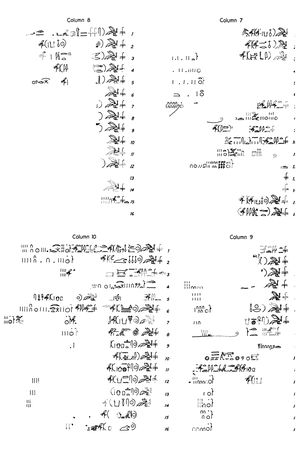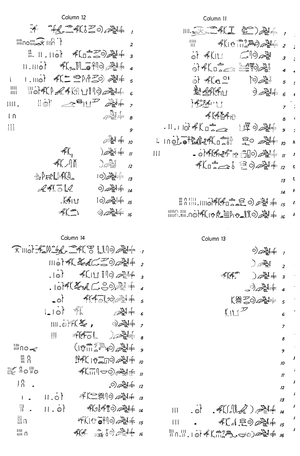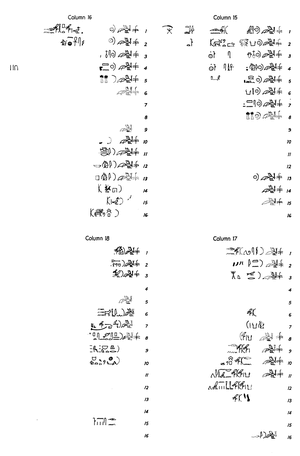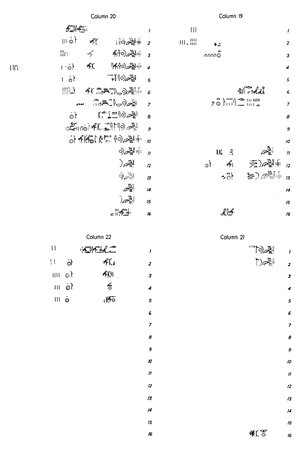The original version of the Royal Canon of Turin
Jaromir Malek
1982
Introduction[*]
The most comprehensive list of Egyptian kings compiled by the Egyptians themselves is on the verso of the sadly fragmented hieratic papyrus no. 1874 of the Museo Egizio in Turin. Whatever the character of its no doubt more detailed primary source may have been, the list was intended to be an official administrative reference aid and thus, presumably, an objective (non-selective) and unbiased document. It provides us, therefore, with a rare insight, limited though it may be, into the Egyptians own view and awareness of their past. The list has attracted scholars[*] since J.-F. Champollion studied it in 1824 and is, consciously or unconsciously, the corner-stone of all chronological schemes for Egyptian history before the Ramessides, even though outwardly Egyptologists range in their attitude towards the information provided by the ‘Royal Canon of Turin’ from ‘fundamentalists’ to ‘rejectionists’.
Before the list can be used as a historical source, a complete reconstruction and clarification of all its aspects are needed in order to understand its character and to evaluate its reliability. A failure to achieve this could result in attempts to endow purely formal features with profound historical significance, a problem which has plagued historians ancient as well as modern. Chronologically, the methods which have been used in the reconstruction can be summarized as follows;
1. The first and most important step; a study of the technical aspects of the papyrus, in particular its fibres, and a transcription of the list. The possibilities offered by this approach were for all practical purposes exhausted when the authoritative edition by A. H. Gardiner[*] appeared in 1959.
2. A comparative study of the contents of the king-list on the verso, i.e. application of historical evidence known from other sources in order to produce a better arrangement of the existing fragments or their more accurate transcription.[*]
3 A transcription, detailed analysis, and understanding of the Ramesside tax-list on the recto, This method is yet to be fully used.[*]
Another attempt to achieve a more complete reconstruction of the king-list is based on the fact that we are dealing with a secondary copy which, in a new guise, retains some of the characteristics of the original. This method is presented here.
Definition of the Problem and the Method
The extant version of the king-list, written on the verso of a discarded administrative document, is a copy which in no way aspires to formal perfection: the text is written in progressively smaller signs, and, despite their incompleteness, it is clear that the later columns tend to contain more lines:
Col. I: at least 25 lines
II: 25 lines
III: 26 lines
IV: 26 lines
V: 25 lines
VI: 27 or more lines (really 29, see below)
VII: more than 23 lines (really 30)
VIII: more than 27 lines (really 31)
IX: 31 lines or more (really 35)
X: 30 (?) lines (really 32)
XI: too incomplete (really 36).
Both features are the result of the scribe’s realization that he was in danger of running out of space before the copy was completed.
Much more significantly, in his haste the copyist did not adjust the ditto-marking of the entries in the new longer columns to correspond formally to the shorter columns of the earlier version. As recognized by W. Helck,[*] the phrase
Line II, 17 : Merbiapen (only traces of the phrase left)
III. 5: Djoser
III. 19: the name is lost, but no doubt Neferirkare
IV. 22: the fifth of the Heracleopolitan kings, with an unclear name, completed by Fragments 48+36 (still unplaced in Gardiner's publication)
VI. 1: Ammenemes IV
VI. 16: Rensonbe
VII. 3: Merneferre
VIII. 4: Sehebre
VIII. 20: Sekhemre
IX. 20: Shemsu[*]
IX. 27: the name is lost
X. 30: the name is lost
XI. 32 (line not numbered by Gardiner): the name is lost.
These should then be the top lines of the columns in the earlier version of the list.
FIG. I. Columns 3-6 of the original version of the Turin Canon. Based on the transcription of Papyrus Turin 1874 in A. H. Gardiner, The Royal Canon of Turin
Reconstruction of the Original Version of the King-list
The first task is to establish the length of a column (‘page’) of the original version (‘master copy’). If we assume that each line normally contained one entry, and that none was left blank, the only variable factors were the totals and the headings. In the existing copy only one sequence of names between two successive occurrences of the phrase ir-nf m nsyt is unbroken and, apparently, without special features (except for two short ‘lost’ notes in VIII. 12 and VIII. 14): VIII. 4 to VIII. 19. This (later established to represent Col. 14) suggests that originally there were sixteen lines to a column. If one leaves aside the gods, demigods, and the kings of the first two Manethonian dynasties for the time being, the columns of the original version can be reconstructed as follows:
Col. 5 = III. 5-18
Only fourteen lines were required in the extant copy, but the entry for Djoser is much longer because it also contains an indication of his age and thus originally almost certainly occupied two lines. The as yet unexplained note after the name of Hu[ni] in III, 8 was probably placed in a special line.
Col. 6 = III 19—IV. 7 (Nitocris); Col. 7 = IV. 8 (Neferka)—IV. 21; Col. 8 = IV. 22—V. 10; Col. 9 = V. 11-25
The heading (V. 19) and the names of the kings of the Twelfth Dynasty which occur before the phrase ir-n f m nsyt in VI. 1 occupy seven lines, and the same applies to the heading (V. 11) and the names of the rulers of the Eleventh Dynasty. The total for the Eleventh Dynasty (V. 18), now in one line, was probably originally extended over two lines; it will be seen from other examples that this always seems to have been the case (less likely, but with the same result, there may have been a blank line following each total). Therefore, Col. 9 = V. 11-25. Line V. 10 contains the total for the eighteen Heracleopolitans, which can again be assumed to have originally taken two lines. Fourteen names are, therefore, needed to complete the column (V. 1-9 and IV. 22-6). Combined Fragments 48+36, still unplaced by Gardiner, provide parts of five Heracleopolitan (Akhtoy) names. The first of these is introduced by
Lines III. 19-IV. 21 are then left for Cols. 6 and 7. The names of the kings belonging to the Fifth Dynasty of Manetho occupy seven lines here, with the total (III. 26) presumably originally again extended over two lines. Von Beckerath has on historical grounds established that Fragment 43, containing the name of Nitocris and those of the first three kings of the Eighth Dynasty, should be moved one line upward in Gardiner’s publication, and the required seven lines are thus neatly taken by the lost names of the rulers of the Sixth Dynasty, concluding with Nitocris. Thus Col. 6 = III. 19-IV. 7 (Nitocris). The section of the list between IV. 8 (Neferka) and IV. 21 is left for Col. 7. This must have been composed as follows: six lines for the kings of the Eighth Dynasty, and four lines for the early Heracleopolitans, leaving another six lines for the very complex total at present occupying only four lines (IV. 14-17).
Col. 10 = VI. 1-15
Two lines must again be allowed for the long total (VI. 3).
Col 11 = VI. 16—VII. 2
The extant copy contains fourteen names between two successive ir.n.f m nsyt entries. Two names have thus probably been lost at the bottom of Col. VI, between
Col 12 = VII. 3-17; Col. 13 = VII. 18—VIII. 3
Indications of altogether twenty-three names art preserved, suggesting two columns of the original version. Assuming that the relative positions of Fragments 86 and 88 are correct, leaving enough space for only one name between them (VII. 10), the last name in Col. 12 would be expected to fall into VII. 18. However, the first entry (VII. 3) is so long that two lines were almost certainly required to accommodate it. Therefore, most probably Co. 12 = VII. 3-17. Only nine names remain for Col. 13, seven names having probably been lost in the lacuna at the bottnm of Col. VII of the extant version.
Col. 15 = VIII. 20—IX. 4; Col. 16 = IX. 5-19
This part of the list is broken by three lacunae: after VIII. 27, IX. 3, and IX, 10. Only one name seems to have been lost in the second of these, and Gardiner's edition suggests that the same may be true in the case of the third. However, since the space is large enough to accommodate two names with hardly any adjustment of the position of the fragments, I reconstruct this section as follows:
VIII. 20-7: 8 names; VIII. 28-31: 4 names lost; IX. 1-19: 20 names (this includes 10A).
Col. 17 = IX. 20—X. 1; Col. 18 = X. 2-13 (of Gardiner's numbering); Col. 19 = X. 14-29 (both of Gardiner's numbering)
This is the most fragmentary part of the list. The reconstruction proposed here seems the best in the circumstances, even though some uncertainty about minor points lingers.
The preserved names and totals suggest that we art dealing with three columns of the original version:
| twenty-one names or their parts and a total (probably 2 lines) preceding the Hyksos six (all but one lost) names (probably six lines) and a total (probably two lines) | 23 lines |
| for the Hyksos | 8 |
| four names of kings after the Hyksos | 4 |
| 35 lines |
The transcription of the tiny traces of signs after the name in IX. 27 must be queried because no grounds for the insertion of the phrase
It seems that the names of the Hyksos rulers introduced[*] Col. 19. The unnumbered fragment with lines X. 14 and 15 probably refers to the first two Hyksos rather than to the preceding total; the position of the fragments in this section of Col. X in Gardiner’s publication must then be adjusted to allow space for six names only. The last line in Col. 17 was probably X. 1 with two names at the bottom of Col. IX lost, making the original number of lines in the latter the high thirty-five. This assumes that two lines (rather than one) have been lost between Fragments 41a and 123 in Col. IX. As a result, in Col. X the position of the unnumbered fragment must be adjusted to create space for another four names before the total (X. 13 in Gardiner's publication).
Col. 20 = X. 30—XI. 15
The Theban rulers neatly fill one full column of the original version of the list, with an unclear summary (?) for the last five (?) in the bottom line.
Col. 21 = XI. 16-31 (...Hb) (unnumbered in Gardiner’s publication)
Altogether thirteen names are lost here.
Col. 22 = XI. 32-36 (unnumbered in Gardiner's publication) and an unknown number from Col. XII (if it ever existed in the extant copy)
In view of the probable lack of separate totals for each group of rulers listed after the Hyksos, Col. 22 probably concluded with a fairly elaborate total. The kings of the Eighteenth Dynasty probably occupied Col. 23.
Now we can return to the beginning of the list:
Col. 1, 2, and 3 = probably I. 1-25, II. 1-16; Col. 4 = II. 17—III. 4
Since for the first two dynasties the list also gave an indication of the king's age, it is virtually certain that some of the entries in Col. 4 occupied more than one line.
New Information obtained from the Reconstruction
- The names on Fragment 40, unplaced in Gardiner’s publication, can be assigned to the top of Col. 16 of the original version (= IX. 5-6) on account of the occurrence of the phrase ir.n[.f m nsyt]. The other possibility, the top of Col. 18, is less likely because of the size of the signs.
- Two names are lost at the bottom of Col. VI.
- Seven names are lost at the bottom of Col, VII.
- Four names are lost at the bottom of Col. VIII.
- In Col. IX, two names are probably lost in the lacuna between Fragments 108 and 112, rather than only one as indicated by the present numbering of the lines. This can be achieved with hardly any adjustment of the position of the fragments.
- The transcription of the remains of the signs after the name in IX. 27 as the beginning of the phrase
ir.n.f m nsyt is probably incorrect. - The lacuna between Fragments 89 and 123 in Col. IX probably contained two names rather than one as suggested by the present numbering of the lines.
- Two names are lost at the bottom of Col. IX.
- The only serious adjustment of the present arrangement of fragments occurs in Col. X. Four names, as opposed to the present one, are suggested to have existed in the lacuna below Fragment 152, but only six spaces instead of the present seven are needed to precede the Hyksos total.
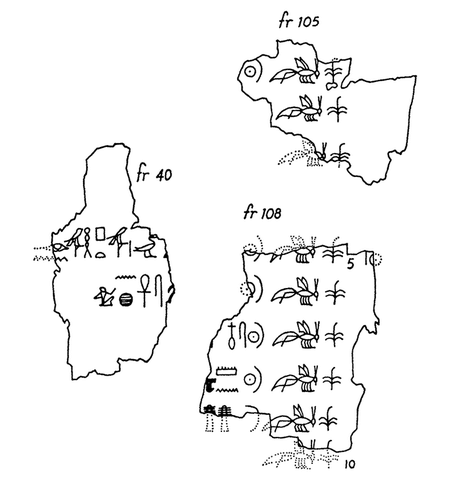
FIG. 6. The suggested position of Fragment 40 in Col. IX of Papyrus Turin 1874 verso. Based on the transcription in A. H. Gardiner, The Royal Canon of Turin
Egyptian Dynasties of Kings as reflected in the Turin Canon
Formally, the reconstructed original version of the king-list appears to be very carefully thought out and designed. The name of Djoser, written in red, was at the top of Col. 5, while the heading for the Thebans of the Eleventh Dynasty, again in red, introduced Col. 9. Also the Hyksos probably occupied a similar position in Col. 19, as did the Thebans contemporary with them in Col. 20. It is reasonable to expect that the same was true for the kings of the Eighteenth Dynasty in hypothetical Col. 23. The early kings of the Nineteenth Dynasty and a concluding text perhaps were in the next column, so that the list originally contained twenty-four columns.
The late Middle Kingdom and the Second Intermediate Period
It has already been noted by von Beckerath[*] that in the Turin Canon the total number of kings for Dynasties XIII/XIV is very dose to the figures given by Manetho:[*] sixty kings for Dynasty XIII, and seventy-six for Dynasty XIV, i,e. altogether 136 rulers, In the original version reconstructed here by using formal criteria these figures can be made to match exactly.
Another set of figures handed down to us by the same historian supports the placing of the Hyksos in our Col. 19. Manetho (Africanus) gives the following information about Dynasties XV-XVII:
| Dynasty XV: | Six Shepherd Kings |
| XVI: | Thirty-two Shepherd Kings |
| XVII: | Forty-three Shepherd Kings |
| Forty-three kings of Thebes. |
Von Beckerath has explained[*] how these figures were arrived at:
| The ‘original version’ of Manetho | Africanus |
| 6 Shepherds | Dyn. XV |
| 32 Shepherds | Dyn. XVI |
| 5 kings of Thebes | |
| Total: 43 Shepherds and kings of Thebes | Dyn. XVII (as 43 Shepherds plus 43 Thebans) |

FIG. 7. The suggested arrangement of fragments in Col. X of Papyrus Turin 1874 verso. Based on the transcription on A. H. Gardiner, The Royal Canon of Turin
The corresponding section of our reconstructed version of the Turin Canon gives the following figures:
6 Hyksos: Col. 19. 1-6 (and two lines of a total)
8 unspecified rulers: Col. 19. 9-16
15 (Theban) rulers, the last five of whom are summarized in a one-line entry (total?): Col. 20. 1-16
16 unspecified rulers: Col. 21, 1-16
9 unspecified rulers: Col. 22. 1-9 (and a long total estimated at seven lines; compare the total after Dynasty VIII which occupied six lines).
When summarized, this gives rise to figures leading to von Beckerath’s ‘original version’, of Manetho: 6 Hyksos (‘Shepherd Kings’); 43 unspecified rulers (‘Shepherds and kings of Thebes’); 5 Thebans.
The Manethonian tradition can thus be well explained from the original arrangement of the names in the Turin Canon, and this makes it likely that a similarly arranged document was used by him. The series of names between the Twelfth Dynasty and the Hyksos probably was not interrupted. The sixtieth name (VIII. 5 = 14. 2) could have been followed by a remark which was misunderstood as an indication of a division. It seems, however, too much of a coincidence that, if these names were to be divided into two more or less equal ‘dynasties of convenience’ with the first ending at the bottom of a full column, the number of lines taken up by the first (XIII of Manetho) urould be sixty (i.e. fifty-eight names, one of which is a double-line entry, plus the heading); the rest (really seventy-eight) could have been derived by subtracting from the now lost total at the bottom of Col. 18. Historically, the neat homogeneous ‘Dynasties’ XIII and XIV are probably fictitious; it is much more likely that after the Twelfth Dynasty the Turin Canon simply listed the names of the rulers known to the compilers of the list.[*] All the 136 known rulers preceding the Hyksos were probably summarized in X. 13 (of Gardiner's numbering) = 18. 15-16. No doubt, there were groups within this assembly, but these were not separated in the list. The Hyksos were treated as a distinct unit, but only the last five rulers of the Theban line were bracketed in some way (though von Beckerath plausibly suggested[*] that this figure might be an ancient mistake for 15). It is remarkable that these did not immediately precede the Eighteenth Dynasty, but were followed by yet another series of local rulers, similar to those immediately following the Hyksos. Neither of these groups was concluded by a total; indeed, if it had been, it would be difficult to explain why Manetho did not regard them as separate dynasties.
The First Intermediate Period
The first four Heracleopolitans are mentioned in Col. 7 of the original version, the remaining fourteen names in Col. 8. The Manethonian (Eusebius) figures of four kings for Dynasty IX and nineteen kings for Dynasty X can be connected with this division, particularly since the name in the now completed line IV. 23 = 8. 2 consists of two cartouches:
| 4 names in 7.13-16 | Dyn. IX | |
| 14 > 15 names in 8.1-14 | ||
| 19 names | Dyn X. | |
The division of Heracleopolitan kings into two dynasties can thus be based on a Manethonian interpretation of the list.
The Early Dynastic Period and the Old Kingdom
No divisions for kings between Menes and Unas which would correspond to Manetho’s dynasties are indicated. The entry for the last ruler of Dynasty VI, Nitocris, was almost certainly followed by a note which gave rise to Manetho's (Africanus) ‘seventy kings of Memphis who reigned for seventy days’. Although not accompanied by a total, this would have provided grounds for the division into Dynasties VI, VII, and VIII. Once again, it seems that Manetho's division into dynasties is the result of his own interpretation of available texts.
It is somewhat surprising at first, though for the Ramesside Period not quite unexpected, to find that it is the name of Djoser rather than that of Menes[*] which provides the first point round which the list was built. Indeed, one wonders why it is his fairly obscure predecessor Necherophes (Nebka) who is heading Manetho's Dynasty III; historically, this is just as hard to explain as the divisions between Dynasties I-II, III-IV, and IV-V. One, therefore, may conjecture that there were other ‘editions’ of the list, some of them based on Menes rather than Djoser, and that such a list was available to Manetho. Nebka's entry would have occupied the first two lines of Col. 5 on account of its length. The entries for Userkaf and Sahure would then have automatically been moved to the top of Col. 6, and those for Merenre-Nemtyemzaf and Nitocris to the top of Col. 7, where an adjustment of the long total would have allowed for maintaining the rest of the list unchanged. Since the entries for the first two dynasties were much longer because of the indications of the age of the kings, Hetepsekhemui (
This would have resulted in Menes’ heading Col. 3. The reasons for the generally accepted division into Dynasties I-V could then be purely formal and unconnected with historical facts; they would result from a Manethonian interpretation of the lists: Menes was the first king from whose reign records were available and thus came to be the first historical king and introduced the First Dynasty; Hetepsekhemui became the first king of the Second Dynasty because in one version his was the first name mentioned in Col. 4 of the list, and Nebka was regarded as the first king of the Third Dynasty because he happened to be placed at the top of Col. 5 of the same list. The reason for starting a new dynasty (IV) after Huni was probably the still unexplained note after his name, originally occupying a whole line. Userkaf may have become the first king of the Fifth Dynasty since he was the first king listed in Col. 6. These divisions are generally used and provide us with a reasonably good chronological framework. Nevertheless, to use them as dividing lines in works on history, an, administration, or any other continuous aspect of ancient Egyptian civilization may be arbitrary and historically unwarranted.
